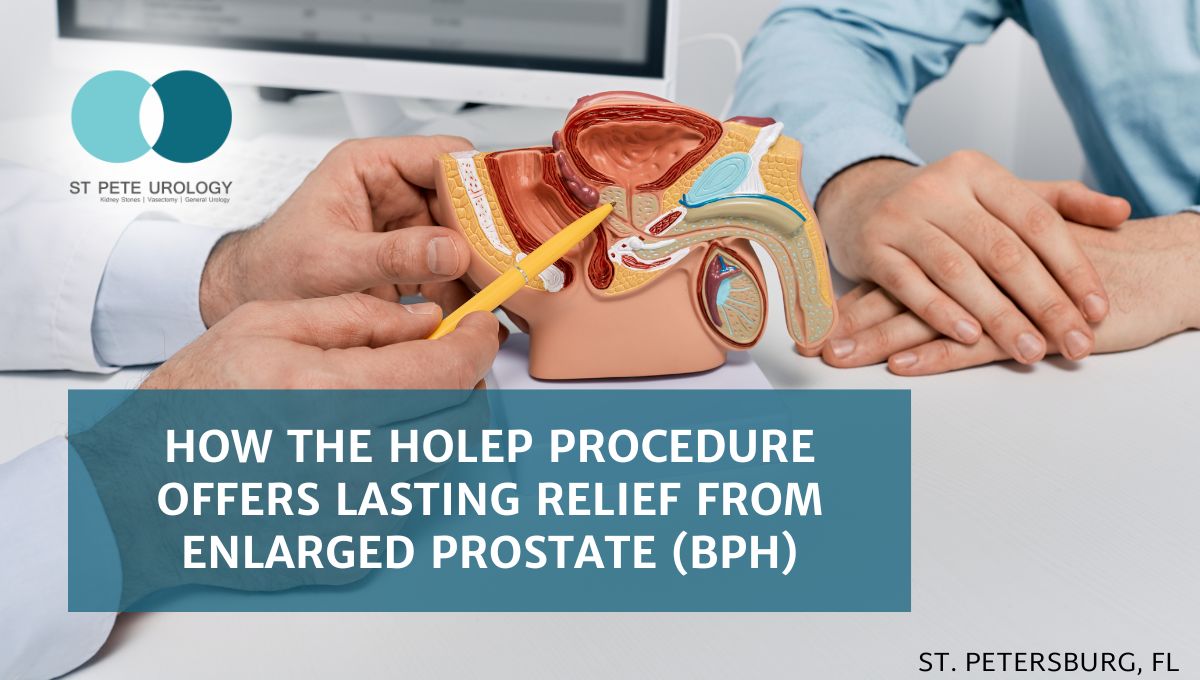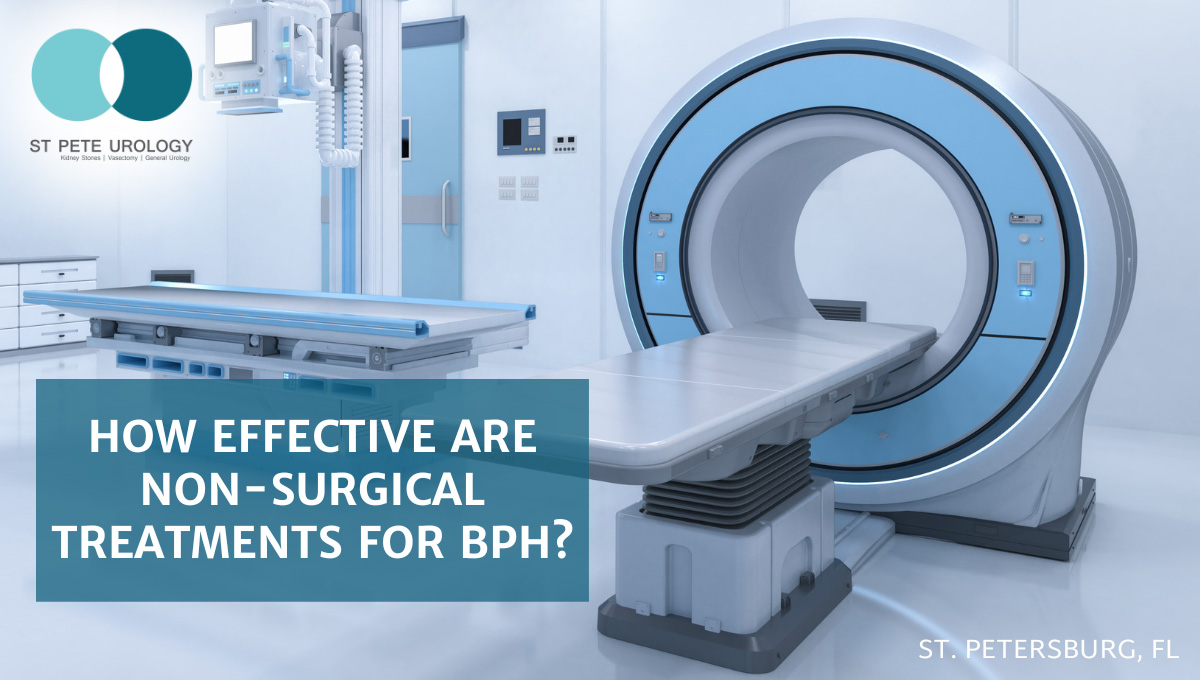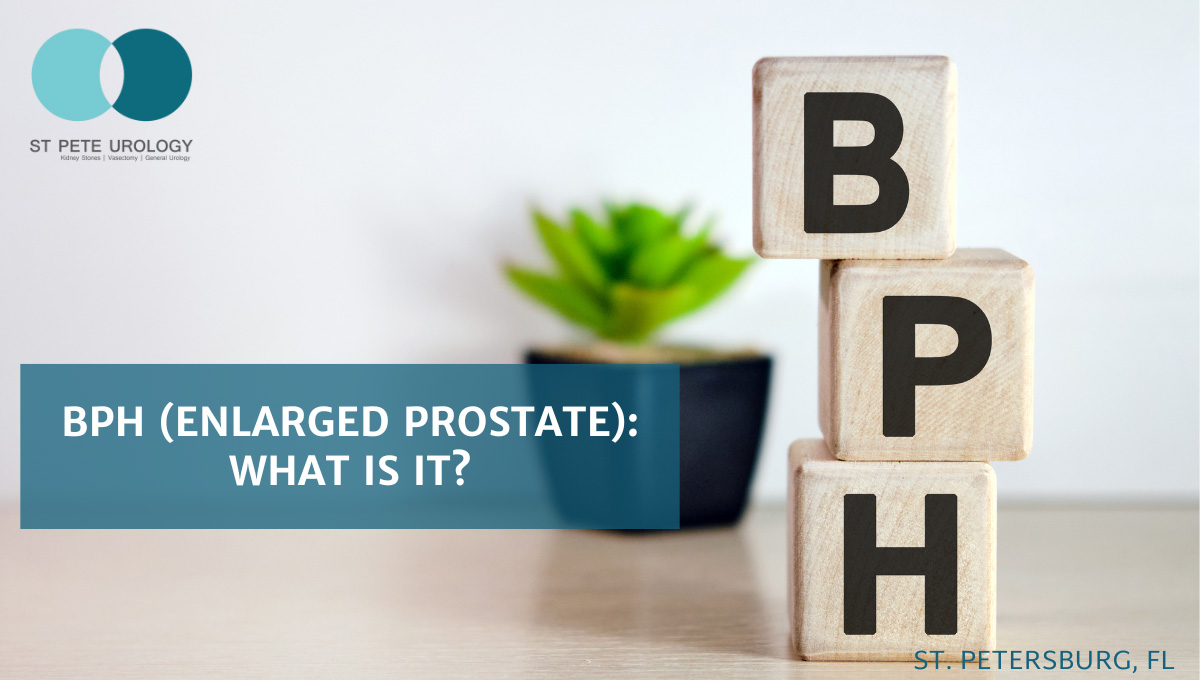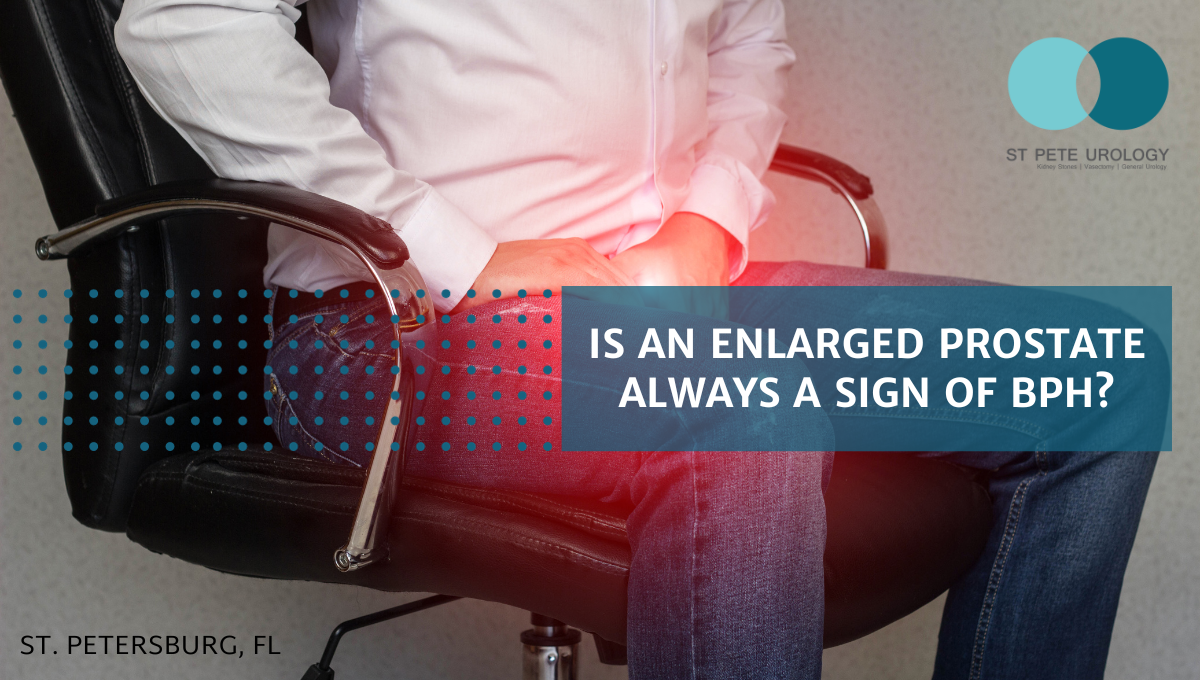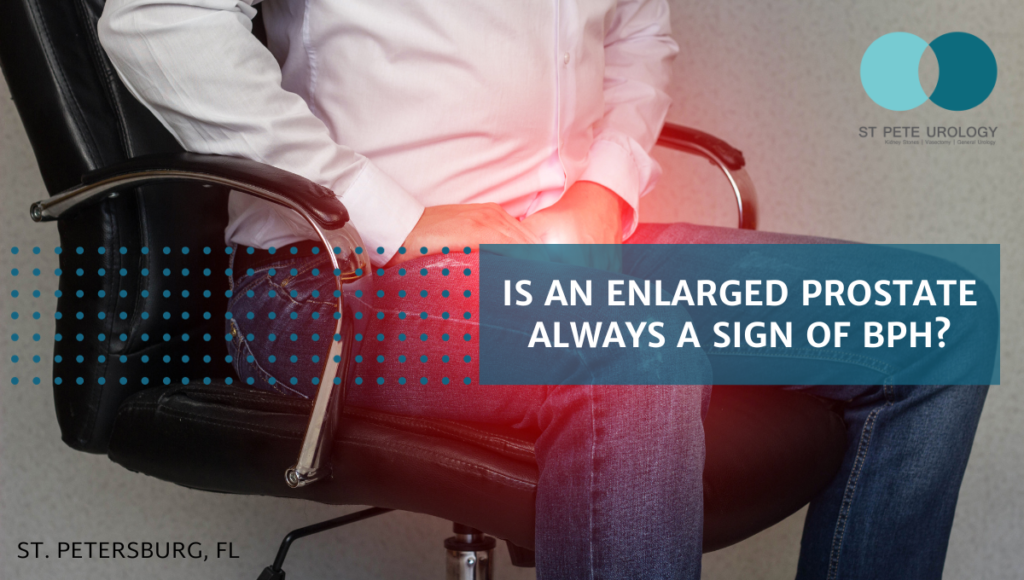Discover how HoLEP procedure and modern BPH treatments offer lasting relief from enlarged prostate symptoms with faster recovery. Expert care in St Petersburg, FL.
Continue readingHow Effective Are Non-Surgical Treatments for BPH?
How effective are non-surgical treatments for BPH? Understanding these treatments is a complex one, so find out more with St. Pete Urology.
Continue readingBPH (Enlarged Prostate): What Is It?
What is BPH or Enlarged Prostate? BPH is a condition that will affect the prostate of nearly every man at some point after the age of 40.
Continue readingIs an Enlarged Prostate Always a Sign of BPH?
How to tell if your prostate is enlarged?
The prostate gland is an integral part of the male reproductive system. It secretes seminal fluid, which nourishes sperm as they grow and facilitates their transportation during ejaculation. It is located between the bladder and the rectum and surrounds the base of the urethra. Due to its location next to key parts of the urinary system, the health of the prostate gland tends to have a direct impact on the health of a man’s urinary system.
The prostate gland grows larger as a man ages. While this gradual enlargement is normal, by the time a majority of men turn 50, the prostate has reached a size where it may start to affect the normal functioning of the urinary organs near it. It is at this point that a man is said to have an enlarged prostate, or clinically speaking, benign prostate hyperplasia (BPH).
Signs and Symptoms of an Enlarged Prostate
An enlarged prostate presses, pinches or causes a blockage in the urethra. The urethra carries urine from the bladder to outside the body. The direct effects of an enlarged prostate are manifested by difficulty in the discharge of urine. These difficulties could be in the form of:
1. Frequent and sudden urges to discharge urine;
2. Difficulty starting a urine stream;
3. Weak urine stream; and
4. Dribbling urine.
If left untreated, the effects of an enlarged prostate can cause the following complications:
1. Acute Urine retention. This is a complete inability to pass urine. Medical attention must be sought immediately if this occurs;
2. Urinary tract infections;
3. Blood in the urine;
4. Pain when passing urine; and
5. Pain in the lower abdomen.
Sometimes an enlarged prostate does not produce symptoms. When this occurs in some men, it may not even be possible to diagnose the condition because it gives them no trouble at all.
The key to diagnosing and treating an enlarged prostate lies with frequent prostate monitoring by a qualified urologist. Men approaching age 50 should get tested or at least keep a watch out for any of the symptoms listed above. The good news is there are many successful treatment options for the condition. Our specialists at St Pete Urology are experienced and well qualified to help with any questions, concerns and treatment. If you think you may have an enlarged prostate, or are experiencing any problems, by all means contact us. For more information, visit the St Pete Urology website.
Early Signs of an Enlarged Prostate
As you grow older, your prostate also grows and swells. But if it becomes very large, it can lead to a condition called BPH (benign prostatic hyperplasia), which simply means your prostate has grown too large though not cancerous. Usually called an enlarged prostate, BPH is a frequent condition in men, especially those in their 50s or older. It is primarily caused by excess DHT, an extremely powerful form of testosterone which triggers aggressive multiplication of prostate cells. Recent studies also indicate that excessive estrogen in the body plays a role in the overgrowth of the prostate.
How can you know that you have an enlarged prostate?
Located right next to the bladder, the prostate is a tiny, walnut-sized gland that’s vital for the normal functioning of the male reproductive system. It is wrapped around the urethra (the tube that takes urine away from the bladder) and significantly influences how the urethra transports both sperm and semen. As the prostate grows and swells, it puts a lot of pressure on the bladder and can obstruct urine flow through the urethra, resulting in various urinary issues.
If you have an enlarged prostate, you will:
- Find it difficult to urinate.
- Experience dribbling after urinating.
- Feel the need to urinate frequently, often at night.
The early warning signs of BPH include:
1. Weak or slow urination
As your prostate enlarges, it puts pressure on your urethra and bladder, interrupting urine flow, resulting in either a weak flow or a prolonged stay in the bathroom. This is a very early and most common sign of BPH, and you’ve probably heard older men joke about how long they take to urinate. So when you have an enlarged prostate, urine does not exit normally and the resulting stream is quite weak.
2. Leaking of urine
Those embarrassing wet spots on your pants may just be the warning that you have an enlarged prostate. Why? Because a swollen prostate not only makes it difficult to urinate, but also makes it harder to retain urine in your bladder, resulting in urine leakage. The enlarged prostate also puts a lot of pressure both on your urethra and on your bladder and compromises your normal ability to hold urine.
3. Straining when urinating
Normal urination requires no effort. So if you find yourself groaning and suffering every time you are in the urinal, it may indicate that your prostate is clamping hard on your urethra.
4. Waking up several times at night to urinate
An enlarged prostate also puts extra pressure on the bladder, producing a sensation that the bladder is full even when it really isn’t. Thus waking up often at night to pass urine may indicate that you have BPH.
5. High PSA during a blood test
While prostate-specific antigen is produced in small quantities in men with healthy prostate glands and plays the critical role of liquefying semen by breaking down large seminal proteins, high levels of PSA may indicate that you have an enlarged prostate or prostate cancer. Make sure that you speak with a doctor if a test shows that you have high PSA in your blood.
6. Sexual dysfunction
BPH can trigger erectile dysfunction and difficulty with ejaculation by applying extreme pressure on the urethra (which transports both urine and semen) and reducing your sexual function. So if you are finding it difficult to have an erection or ejaculation, you should see your doctor for an examination to identify the problem. It may just be an enlarged prostate.
How can a urologist help?
When you experience the warning signs, you need to see your doctor to determine if you have an enlarged prostate. If an examination establishes that you have BPH, the urologist will recommend the right treatment. The most common approaches to treating BPH include:
1. Watchful waiting (active surveillance): If during assessment it is found that your symptoms are mild and not very troublesome, the urologist may recommend that you wait for a while before you commence treatment. Your symptoms will be monitored during this period to see if they are getting worse and require intervention. Your doctor will determine how frequent you need to go for checkup. The treatment can be started later if the symptoms worsen.
2. Medications: Your urologist may recommend medicines for shrinking the prostate gland or to relax the muscles around the gland in order to reduce or relieve symptoms. Make sure to speak with your doctor about possible side effects of these medicines.
3. Surgery: If medicines fail, the urologist may suggest that you undergo surgery to help improve urine flow. Different types of surgical procedures can be used, so talk to your doctor about the right option for you and about the risks involved. After surgery, regular medical checkups are very important.
4. Other treatments: To reduce the extra prostate tissue and relieve urinary problems associated with BPH, treatments such as microwaves, lasers or radio waves may be considered.
Want to know more about the health issues associated with the prostate, their diagnosis and treatment? Or you suspect that you have a prostate problem and want to speak to a knowledgeable and experienced urologist? Get all the information and help you need today by visiting the “St Pete Urology” site.
What is the best medicine for enlarged prostate?
Treatment options for benign prostatic hyperplasia (BPH) have increased significantly in recent years. A few years ago, men suffering from BPH only had surgery as the main treatment option. This has changed as drug-makers have developed a number of drugs to offer more choices for alleviating the symptoms of an enlarged prostate. In fact, medicines now have become the most common treatment method for men with mild-to-moderate BPH. When administered, the drugs can calm bladder and prostate muscles, shrink the prostate, stop prostate growth or relieve symptoms of BPH, such as weak urine streams or the need to urinate several times per day.
Here are some drugs commonly used to treat BPH. Before using any drug, make sure to speak with your doctor to find out which medicine is appropriate for you.
1. Alpha blockers
When diagnosed with an enlarged prostate, your doctor may recommend that you take alpha blockers to ease your symptoms. These drugs relax bladder and prostate muscles and make it easier to pass urine. While they do not alter prostate size, they are effective in promoting urine flow and will prevent the need to urinate frequently or urgently. They work right away so you will not wait too long for the results.
Some alpha blockers that your doctor may suggest include:
- (a) Doxazosin (Cardura)
- (b) Alfuzosin (Uroxatral)
- (c) Tamsulosin (Flomax)
- (d) Silodosin (Rapaflo)
- (e) Prazosin (Minipress)
- (f) Terazosin (Hytrin)
Alpha blockers are very effective for men with both BPH and high blood pressure because they remedy both conditions. However, the drugs should not be taken by men planning to go for cataract surgery as they may cause problems during the surgery.
Side effects of alpha blockers include:
- Tiredness/fatigue
- Fainting
- Dizziness
- Lightheadedness
- Headaches
- Low blood pressure
Alpha blockers also can cause retrograde ejaculation, a condition in which sperm moves backward into the bladder instead of moving forward through the penis. While the condition is not harmful, it means that the fluid ejaculated may not contain sperm. Therefore, men with BPH should keep this in mind particularly if they still desire to have children.
2. 5-Alpha reductase inhibitors
In order to prevent the prostate from growing or just to shrink it, the urologist may recommend that you take a 5-alpha reductase inhibitor. Such drugs stop the body from producing one of the hormones necessary for prostate growth and enlargement. As a result, the drugs improve urine flow and relieve the symptoms of BPH. The 5-ARIs are most effective in men with very large prostates.
The two major 5-alpha reductase inhibitors recommended for BPH are:
- Dutasteride (Avodart)
- Finasteride (Proscar, Propecia)
Apart from shrinking or stopping the growth of the prostate and relieving BPH symptoms, the 5-ARIs have two other benefits:
- They reduce the chances that BPH will result in other complications, like bladder damage.
- They eliminate the need for surgery as treatment for BPH.
The full effects of 5-alpha reductase inhibitors may take up to 6 months to be realized. So you must continue taking the medicines for as long as necessary.
Side effects of 5-ARIs
5-alpha reductase inhibitors are not supposed to be used by women. In fact, pregnant women must never be exposed to the drugs as they can cause birth defects in male fetus. Other side effects of 5-ARIs include:
- (a) Lower sex drive/libido
- (b) Erectile dysfunction
- (c) Retrograde ejaculation
Some of these side effects may improve as the body gets used to the drug.
The 5-ARI drugs also may reduce the levels of prostate-specific antigen (PSA) in the blood. PSA levels are used to screen for prostate cancer, so a drug-induced drop makes it impossible to use the PSA test. It is advisable to have the PSA test done before you start these drugs. The FDA now requires that the labels on 5-ARIs must include a warning that they may increase the risk of having aggressive (high-grade) prostate cancer.
3. Phosphodiesterase-5 inhibitors
In some cases of BPH, the urologist may recommend the use of phosphodiesterase-5 inhibitors, which are drugs that smooth the muscles of the prostate and bladder and help to relieve BPH symptoms. While there are many types of phosphodiesterase-5 inhibitors, only tadalafil (Cialis) has been approved by the FDA for treatment of BPH. Tadalafil is not prescribed as often as other drugs, but when doctors are dealing with cases in which BPH and ED occur together, then it is often a viable option.
The side effects of Tadalafil include:
- (a) Headaches
- (b) Muscle and back pain
- (c) Stomach upset (after eating)
- (d) A stuffy nose
- (e) Vision problems
- (f) Redness, warmth or burning on the neck, face and upper body
4. Combination therapy
When a doctor realizes that a single medication may not effectively relieve BPH symptoms, a combination of two or more drugs may be considered. The most common drug combinations for treating BPH include:
- (a) Tamsulosin and Dutasteride, comes in one pill called Jalyn
- (b) Doxazosin and Finasteride
- (c) Alpha blocker and an antimuscarinic (a drug for treating overactive bladder)
Drug combinations are generally more effective than single drug treatments. However, the combinations also come with greater side effects than those of single drugs.
Are you or your loved one suffering from the symptoms of BPH? Would you like to receive accurate information and effective treatment for an enlarged prostate? Or do you want someone to to talk to about any other urological problem that you may have? If so, then St Pete Urology is the right place for you. For more information on the diagnosis, treatment and care for BPH, visit the “St Pete Urology site.
Enlarged Prostate – The Apple Analogy Explained
As the Prostate Gland increases in size, it puts pressure to the neighboring organs specially the urethra, resulting into the constriction of the urethra passage. [Read Full Article…]

